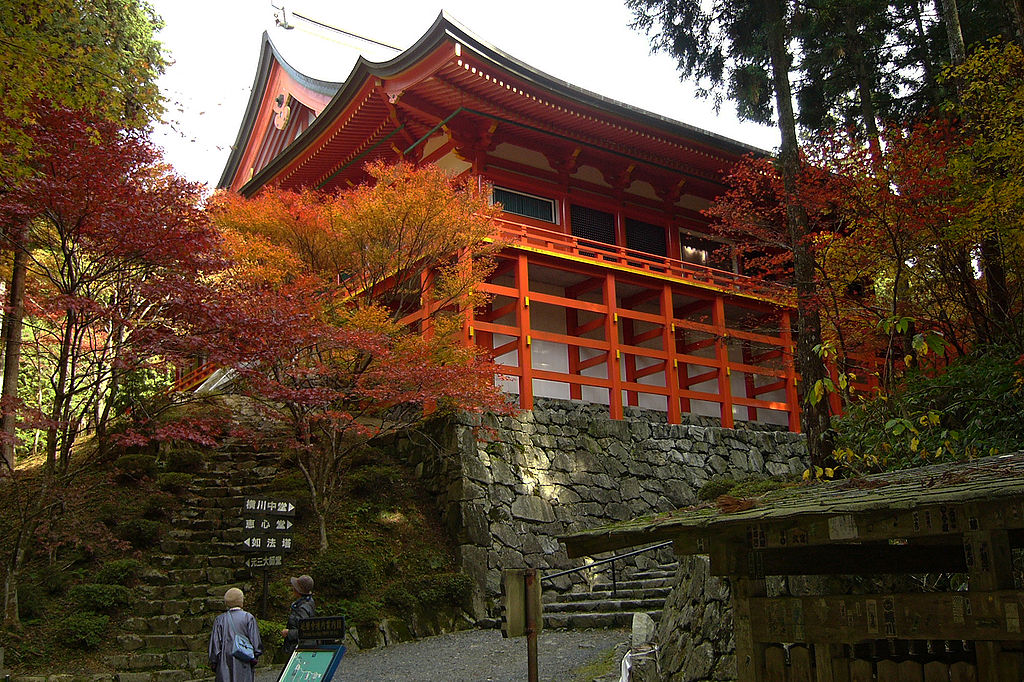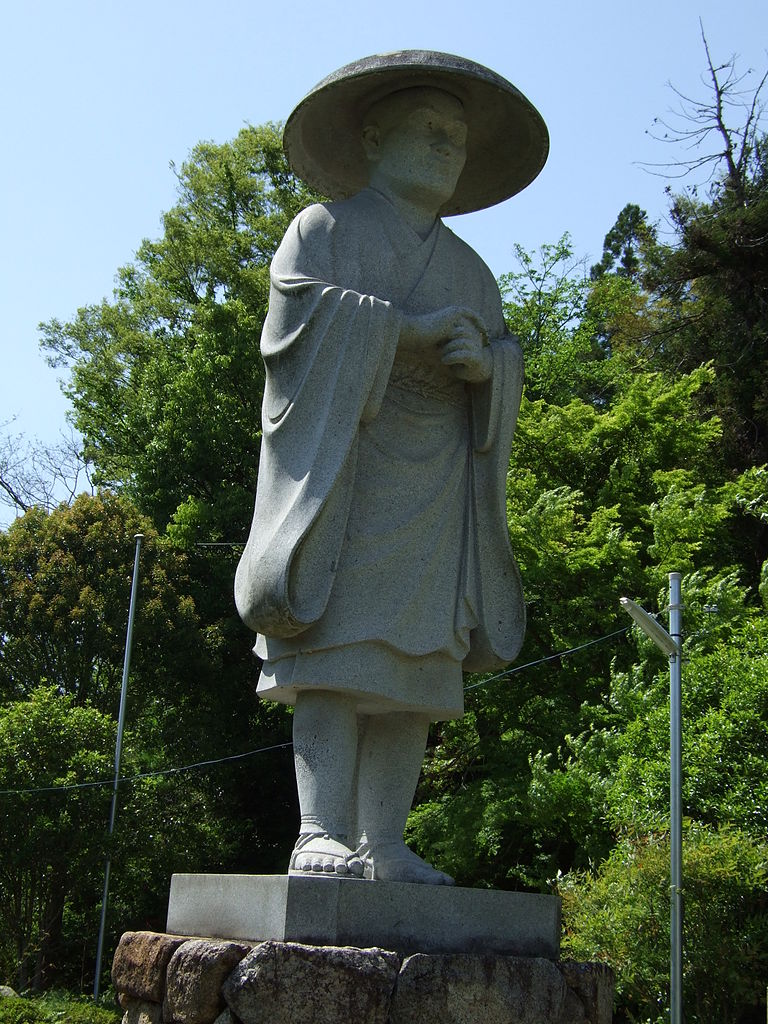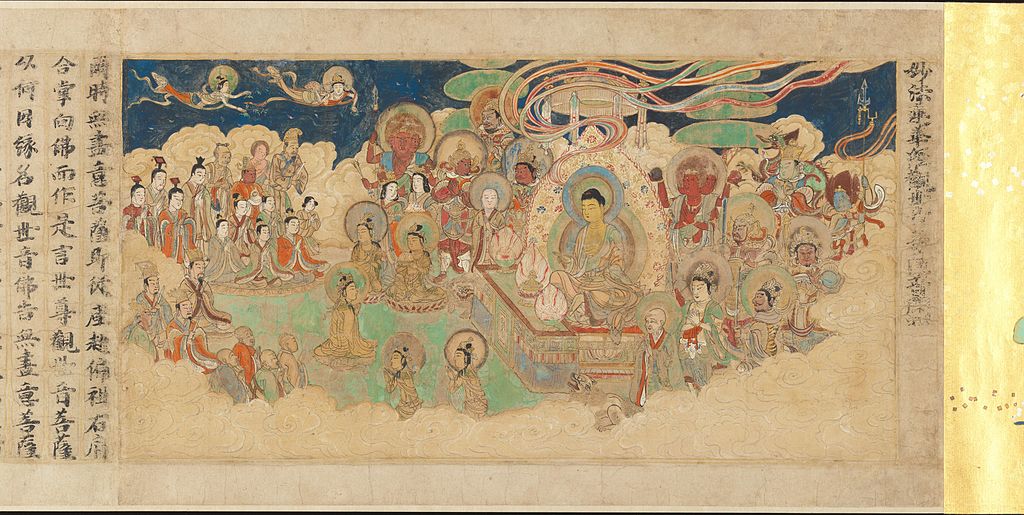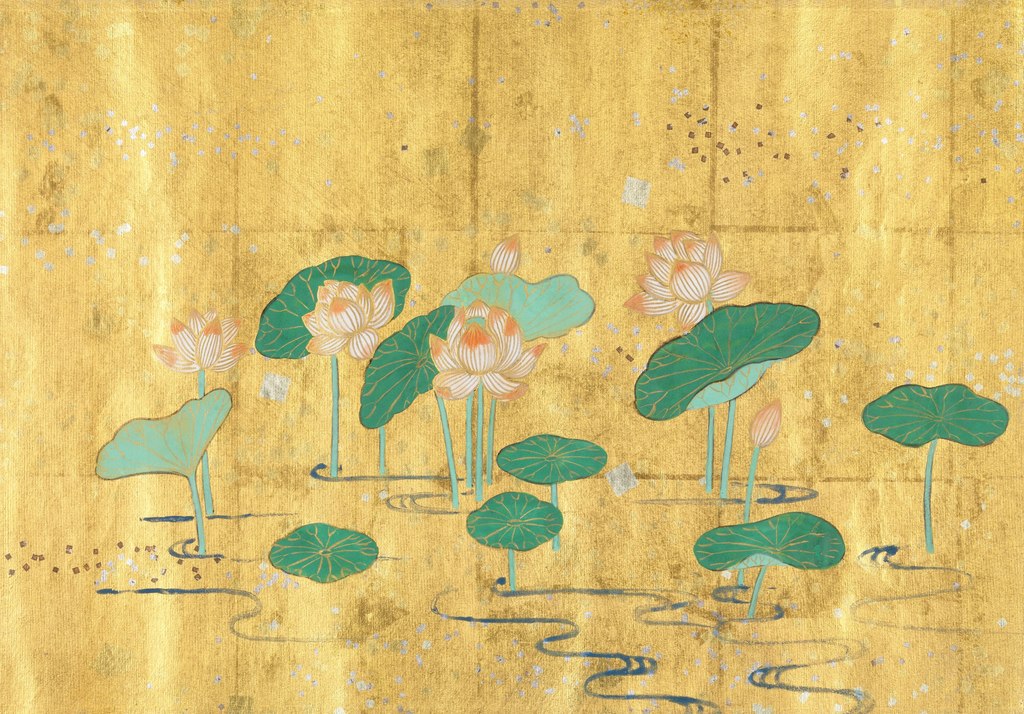
Even though Kukai, the founder of the Shingon school, is regarded as the first Japanese Buddhist teacher to engage seriously the concept of original enlightenment, together with the esoteric teachings he had brought back from China, it is with the Tendai school that the development of original enlightenment thought is associated. Kukai focused primarily on translating these teachings into actual practices on Mt Koya, whereas on Mt Hiei, Saicho was instrumental in bringing about a number of innovations that allowed hongaku to flourish, not so much during his lifetime, but throughout the following centuries during which his disciples worked at integrating the Lotus Sutra with the esoteric teachings.
The Tendai temple of Enryaku-ji which Saicho built on Mt Hiei was not just a temple. It was a monastic institution with three thousand sub-temples, which was to play the role of a Buddhist university for many centuries. Before being drawn to the Tiantai school, Saicho had been ordained in the Kegon (Ch Huayan) school. In China, he had also received initiation from a Chan master of the Ox Head school. And, he had, of course, received a number of initiations in esoteric teachings from Kukai. So he could offer a wide range of teachings as well as practices, in addition to Zhiyi’s Tiantai teachings based on the Lotus Sutra and the Threefold Truth, – in particular Mitsu (Mikkyo – Esoteric teaching based on the Mahavairocana Sutra), Zen meditation, and Kai (Mahayana Precepts). Monks were encouraged to seek new insights through their personal practice, guided by masters through the use of private transmission papers called kuden. Ultimately, it is on the basis of these kuden that a sophisticated understanding of original enlightenment was achieved in the course of the next three centuries.
Esotericising the Lotus Sutra
Jacqueline Stone describes the first moves made by Saicho’s disciples under four headings: esotericising the Lotus Sutra, redefining the Buddha, valorising the phenomenal world, shortening the path.
These moves, initiated by Ennin (793/794-864) and Annen (841–889) reflected a significant influence of the esoteric teachings that Kukai had brought back from China. She writes, “So thoroughly esotericized did Tendai doctrine become in Annen’s thought that he habitually designated his school not as Tendai/Lotus, but as shingon (shingonshu).”

The first significant move was made by Ennin who had himself traveled to China in search of esoteric initiations, and lived through the Huichang persecution of all foreign religions, including Buddhism, initiated by Tang emperor Wuzong from 842 to 846. He had, in the end, been deported back to Japan in 847 and, in 854, he became Enryaku-ji’s third abbot.
In keeping with the Tiantai/Tendai traditional teachings, Ennin presented the adoption of esoteric teachings as part of the school’s commitment to the principle of inclusivity of all Buddhist teachings. At the same time, he had to retain the Lotus Sutra as the core text of the school. So he “put forth the notion of the “one great perfect teaching,” in which the whole of Buddhism was encompassed” and he launched into a re-classification of sutras into exoteric and esoteric texts.
It will help if we remember here that “esoteric” is not an accurate translation of the word used at the time by Kukai and Saicho. The word used by Kukai was “mikkyo,” and that used by Saicho was “mitsu,” though modern Tendai teachers also use the word “mikkyo.” The literal meaning of “mikkyo” is “mysterious.” What is “mysterious” to us is what we cannot understand at our level of consciousness. For instance, texts written from the standpoint of the enlightened mind for anyone who is still stuck in dualistic thinking. In particular, it is difficult for us to understand how practices such as mantras, visualisations, mudras, and mandalas, can help us actualise our original Buddha-nature. In addition to the claim that Mikkyo teachings would allow us to access enlightenment in our own lifetime, the criteria for what was Mikkyo and what was not, included whether a teaching reflected the experience of an enlightened master, the privileged status of phenomena in relation to “suchness,” and a reference to the “tantric” practices quoted above.
On this basis, Stone explains that, “within the category of “esoteric teachings,” Ennin included such Mahayana sutras as the Avatamsaka, the Vimalakirti, the prajna-paramita sutras, and of course the Lotus, along with the [esoteric] Mahavairocana Sutra and Diamond Crown Sutra.” As neither the Mahayana texts nor the Lotus Sutra included any mention of “tantric” practices, “Ennin found another distinction to be necessary. All esoteric scriptures were equal in principle … in that they taught the nonduality of worldly and ultimate truth, [that is, they reflected the standpoint of the enlightened mind] but they differed in their treatment of specific practices. That is, the Lotus was esoteric “in principle alone,” while the Mahavairocana Sutra and other sutras that set forth the specifics of mudras, mantras, and mandalas to be used … were esoteric in both “principle and actual specifics.” Note that “Saicho had relegated Mahayana sutras other than the Lotus to the status of provisional teachings.”
Stone adds: “A further development in the notion of the “one great perfect teaching” occurs in Annen … with his concept of the “four ones” – one Buddha, one time, one place, and one teaching.” What is meant here is that the “one great perfect teaching” included the teachings of all Buddhas throughout the three times and the ten directions, in other words, “the whole of time and space, which is affirmed as the realm where the originally inherent Buddha constantly and universally preaches to living beings. Annen’s “four ones” were clearly influenced by esoteric concepts of the Dharma-body Buddha whose body and mind are identified with the entire phenomenal world.”

In the end, “rather than encompassing Mikkyo within the framework of the one vehicle of the Lotus as Saicho had intended, [Tendai Mikkyo] developed an esoteric reading of the one vehicle that tended to subsume the Lotus within Mikkyo.” This is what is meant by the esotericisation of the Lotus Sutra. “Medieval Tendai hongaku thought emerges in large part as an attempt to reinterpret traditional Tiantai/Tendai doctrines through the lens of an esotericized sensibility.”
Redefining the Buddha
As the Lotus Sutra came to be understood as an esoteric text, there arose a need to identify its “Primordial Buddha” with the Buddha of the esoteric teachings.
In Chapter 16 of the Lotus Sutra, entitled “Fathoming the Lifespan of The Tathagata,” we read: “The devas, humans, and asuras in all the worlds all think that the present Buddha, Sakyamuni, left the palace of the Sakyas, sat on the terrace of enlightenment not far from the city of Gaya, and attained highest, complete enlightenment. However, O sons of a virtuous family, immeasurable, limitless, hundreds of thousands of myriads of kotis of nayutas of kalpas have passed since I actually attained buddhahood … Since then I have constantly been residing in the saha world, teaching the Dharma and inspiring sentient beings.”
“Hundreds of thousands of myriads of kotis of nayutas of kalpas” definitely sounds like an extremely long time but, as Gene Reeves notes in Stories of the Lotus Sutra, it is not “outside time.” As this was coming out of the mouth of Sakyamuni himself, the most obvious meaning of this revelation was simply that he had not entered paranirvana as described in Theravada suttas. In other words, he was still alive, but this still did not mean that he was “eternal.”

In fact, immediately following this dramatic statement, a story is told of a physician whose sons had unknowingly drank poison, who had faked his own death to cause them a grief so deep that those who, because of the poison, had lost their faculty of reason, would return to their senses, and accept the antidote he had prepared for them. Then, coming back to Sakyamuni, the sutra reports him as saying: “Although I am always among these erring beings, with my transcendent powers, I prevent them from seeing me … For if they were to see me, they would become lazy and arrogant. Attached to the desires of the five senses, they would fall into the troubled states of being.” So the story of the physician had clearly been brought up to explain why Sakyamuni has led them to believe in the story of his leaving the palace, and attaining enlightenment under the Bodhi Tree. This story was a “skillful means” that, as explained in Chapter 2 of the sutra, was used by Sakyamuni to adapt his teachings to the level of understanding of his followers. What this meant is that the teachings recorded in the Theravada suttas were only “provisional” teachings. So far, however, there was still no hint that Sakyamuni was other than the Buddha who has attained enlightenment in the far distant past, though historical humans do not normally live that long!
Stone notes that Chinese commentators on the Lotus had explained Chapter 16 by bringing up the Trikaya doctrine which had been systematised by the Yogacara school around 300 CE. According to this doctrine, the Buddha has three bodies: the dharmakaya (ultimate reality), the sambhogakaya (recompense body, for example, Amithaba and Manjusri) and the nirmanakaya (manifested body, physical appearance in the world).”
Kukai, who regarded the Lotus Sutra as an exoteric text, referred to Shakyamuni as the nirmanakaya, the human Buddha who appears in this world. Zhiyi (Chi-i) identified him as the sambhogakaya. Stone writes: “Since the recompense body both realizes the truth that is the Dharma body and responds to aspirations of the beings in the form of the manifest body, Chi-i regarded it as central. However, he also rejected any notion of hierarchy among the three bodies, denying that one can be seen as prior to the others. [Chi-i also said] that the three bodies were inseparable.” Such an approach, Stone argues, opened the way for Sakyamuni’s identification with the Mahavairocana/Dainishi Buddha of esoteric teachings.
“This identification is also found in Saicho’s writing … After Saicho’s death, his successors continued to elaborate in esoteric terms the unity of the two Buddhas … They redefined Sakyamuni of the Lotus Sutra … as an originally inherent Buddha, without beginning or end. He is, in Annen’s words, the one Buddha who is all Buddhas, who preached continuously throughout all space and time. And, since the Dharma body is originally inherent in all phenomena, ordinary worldlings are in essence Buddhas, too; between the enlightened and the unenlightened, no ontological distinction whatever can be made.”
Valorising the Phenomenal World
The Chinese Tiantai tradition had already gone further than the Awakening of Faith and the Huayan school in terms of revalorising phenomena. Zhiyi had denied “that the mind is a pure, undifferentiated cosmic principle from which all things arise.” Instead, he had privileged “entering emptiness from conventional existence,” which reflects an “emphasis on concrete particulars as instantiating ultimate truth: “Of every form and fragrance, there is none that is not the Middle Way.” It is this move that Tamura Yoshiro had referred to when he said that “T’ien-t’ai moves from shih (phenomena) to li (principle), stressing that each particular as it stands encompasses the true aspect of reality.”
“This emphasis on the phenomenal was underscored in Saicho’s appropriation of the doctrine of ‘suchness according with conditions’ in a way that gave priority to the dynamic aspect of suchness, that is, its expression as the phenomenal world.”
With the integration of esoteric teachings as articulated by Kukai, and the identification of the Buddha as revealed in Chapter 16 of the Lotus Sutra with the esoteric Mahavairocana/Dainishi Buddha, the concrete world of phenomena was given even greater importance. “Kukai had taught the esoteric doctrine of the six great elements – earth, water, fire, wind, space, and consciousness – which comprise all things in the cosmos and are the body and mind of Dainichi Nyorai. To see colours, shapes, throughts, and so forth as body of the originally inherent Buddha is to endow them with heightened sacrality; Kukai took this one step further to argue that all phenomena were in fact the “preaching” of the Dharma body (hosshin seppo), by which Dainichi is revealed.”
Beyond the theoretical debate about whether Sakyamuni Buddha was the nirmanakaya, the sambhogakaya, or the dharmakaya, or all three at once, was the way in which a phenomenal world equated with the body, speech, and mind of the cosmic Buddha Dainichi transformed practice beyond recognition.
“The valorization of the phenomenal world in Mikkyo thought was grounded in the bivalent meaning of the “three mysteries.” On the one hand, the three mysteries are all forms, sounds, and thoughts, that is, the entire phenomenal world, equated with the body, speech, and mind, of the cosmic Buddha Dainichi. On the other hand, the three mysteries are the concrete forms of esoteric practice by which identity with Dainichi is realized: the intricate mudras formed with the hands and body; the vocally recited mantras and dharanis; and the mental contemplations of the holy figures represented on the mandalas … The categories of ri and ji, in addition to their earlier meanings of “principle” and “phenomena,” assumed new connotations in the realm of esoteric practice, ri being the timeless paradigm to be contemplated inwardly, and ji, its physical and temporal imitation or expression in actual practice. For ex., ri is the mental visualization of the Buddha, while ji is the Buddha image standing on the altar.”
Silent contemplation gave way to “practices with form” like the chanting of mantras and practices involving visualisations, mudras and mandalas. “One sees in the latter Heian period a general shift across Buddhist traditions away from silent, introspective contemplative toward practices having concrete form. This is evident, for ex., in the way that the chanting of the nenbutsu, the name of the Buddha Amida, emerged alongside, and eventually superseded, the silent contemplation or visualization of the Buddha.”
“This emphasis, rooted in Mikkyo, on ji (phenomena) as the concrete forms of practice by which enlightenment is said to be realized experientially, also enhanced the value accorded to ji in the broader sense as the actualities of the phenomenal world. The phenomenal world as the locus of truth was expressed in the Tendai tradition by such terms as “the real is identical with phenomena” (sokuji nishin) or – an expression especially popular in the medieval period – the “constant abiding of the worldly truth” (zokutai joju).”
Source:
Jacqueline I. Stone – Original Enlightenment and the Transformation of Medieval Japanese Buddhism

